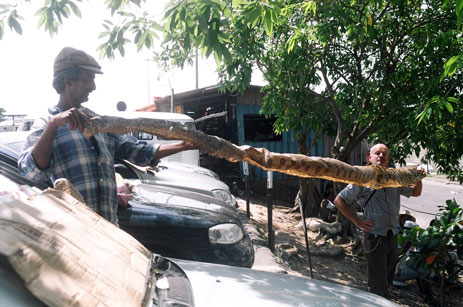
As Quoted By Robert Young Pelton
- If you are attacked by an anaconda, do not run. The snake is faster than you are.
- Lie flat on the ground. Put your arms tight against your sides, your legs tight against one another.
- Tuck your chin in.
- The snake will come and begin to nudge and climb over your body.
- Do not panic.
- After the snake has examined you, it will begin to swallow you from the feet and always from the end. Permit the snake to swallow your feet and ankles. Do not panic.
- The snake will now begin to suck your legs into its body. You must lie perfectly still. This will take a long time.
- When the snake has reached your knees slowly and with as little movement as possible, reach down, take your knife and very gently slide it into the side of the snake’s mouth between the edge of its mouth and your leg, then suddenly rip upwards, severing the snake’s head.
- Be sure you have your knife.
- Be sure your knife is sharp
... from the U.S. Government Peace Corps Manual for its volunteers who work in the Amazon Jungle. It tells what to do in case you are attacked by an anaconda, the largest snake in the world. It is a relative of the boa constrictor, it grows to thirty-five feet in length and weighs between three and four hundred pounds at the maximum.

heya Tones,
i just found your site. google didn’t help a lot until i used the search terms (“tony phillips” “south america” tones travel).
i guess my proposal to google (pending once i figure out if IBM can actually own an idea i’ve had for over three years) about ways to utilize sequential related search terms as an indicator of “failed search” is valid. lexically speaking, if it can be demonstrated that sequential searches are related (lexically and semantically), there is by definition a collaborative nature to that sequnce that informs Google that their Pagerank metric is ‘failing” and a key indicator that some other more direct metric (like a cF based success prediction) could be the real answer!
In any event, I hope you are well.
in the context of this thread…
…an anaconda is fairly fast only in water. on land it is almost wholly known as being “slow as hell”, mostly due to its weight and girth. My first advice in such a wildlife encounter would be to stand some distance behind its head and beyond its reach (roughly 1/6 of its overall length), and observe it (if it is on the ground) since getting to view such an amazing (and endangered due to human encroachment) critter up close and personal is a real and rare treat.
if in the water and an anaconda shows interest, I (and LikeMinds) would recommend that you get the hell out of the water ASAP!
take care my friend. i hope you are well and enjoying your adventure. mine continues, although in one week i will be off IV therapy and will enjoy a three week “clearing the bloodstream” phase to see where we go next!
all my very best to you, my friend!
tV